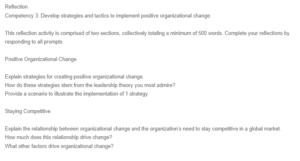Strategies and Tactics to Implement Positive Organizational Change
Positive organizational change
Transparency is one of the strategies for positive organizational change. Major changes that directly affect employees or work procedures should involve or engage the staff members. Such transparency reduces the fear that is associated with new developments at the workplace. Such transparency means that the involvement of employees is inevitable. Employees are involved in the daily activities that yield different products and services. Therefore, involving them in the change process is important in gaining their support and acknowledgment of the process (SHRM, 2021). Eventually, this reduces resistance from the staff members.
These strategies align with the servant leadership style, which seeks to involve employees in all organizational activities. As servant leaders actively listen to the employees, they seek out their opinions on certain issues that may be part of a planned change process (Kruse, 2021). Once employees have the chance to participate in the process of change, they also provide constructive criticism about the process, which leads to improvement.
A manufacturing company that seeks to change the process of production of goods may need to involve the technicians involved in each department. This involvement allows technicians to provide their opinions on the actual problems they face during product development. In addition, the employees will highlight aspects that they believe would improve the process more. This insight is important because technicians are involved in daily activities and are aware of the challenges; thus, they can offer solutions.
Staying competitive
Organizations need to remain adaptive to the changes that occur in their environments. Organizations that fail to embrace changes lack the ability to compete efficiently. Most organizations experience changes in work procedures, marketing activities, employee management, and production to improve quality. These changes are important to the company’s sustenance. If an entity remains adamant and refuses to change, it is unable to incorporate the new changes in its environment. Furthermore, other organizations gain a higher competitive edge by incorporating changes and surpassing slower entities. Therefore, the various changes provide an opportunity for quality improvement.
The need to remain competitive is a significant driver of change because it keeps entities on their toes regarding the dynamic elements in their environments. The various entities must remain updated about the various developments that take place in their industries. These may include aspects such as increased Corporate Social Responsibility activities or going green. These elements force organizational change because they affect the company’s ability to appeal to the global market. Failure to include such changes paralyzes an entity’s ability to compete efficiently.
Other factors that drive organizational change include threats and opportunities as well as weaknesses. The weaknesses provide a chance to improve the current offerings. Threats force an entity to review its strategies to avoid business loss. The opportunities offer a chance to find new business deals and increase income. The threats are beyond an organization’s control, while the weaknesses are within its control. The opportunities can be manipulated to bring about better performance in an entity (The University of Kansas, 2021).
References
Kruse, K. (2021). Servant Leadership: Definition, Examples, Characteristics.
SHRM. (2021). Managing Organizational Change. Retrieved from https://www.shrm.org/resourcesandtools/tools-and-samples/toolkits/pages/managingorganizationalchange.aspx
The University of Kansas. (2021). Section 14. SWOT Analysis: Strengths, Weaknesses, Opportunities, and Threats. Retrieved from https://ctb.ku.edu/en/table-of-contents/assessment/assessing-community-needs-and-resources/swot-analysis/main
ORDER A PLAGIARISM-FREE PAPER HERE
We’ll write everything from scratch
Question

Strategies and Tactics to Implement Positive Organizational Change
Reflection
Competency 3: Develop strategies and tactics to implement positive organizational change.
This reflection activity is comprised of two sections, collectively totaling a minimum of 500 words. Complete your reflections by responding to all prompts.
Positive Organizational Change
Explain strategies for creating positive organizational change.
How do these strategies stem from the leadership theory you most admire?
Provide a scenario to illustrate the implementation of 1 strategy.
Staying Competitive
Explain the relationship between organizational change and the organization’s need to stay competitive in a global market.
How much does this relationship drive change?
What other factors drive organizational change?

